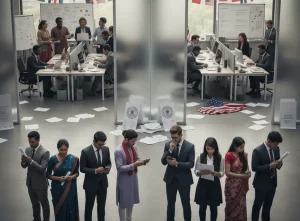How to Manage, Engage and Motivate a Hybrid Workforce Long-Term
Published on
Almost a year-and-a-half into the pandemic, we’ve heard and seen it all. All of us were forced to work from home at an instant notice, some of us went back to office occasionally after the first wave subsided and, by now, we know one thing for sure — the future of work is going to be different. Even amid reports of CEOs giving ultimatum to employees to return to work or face pay cuts, there is consensus among most leaders about adopting a hybrid work model in post-pandemic world.
As we transition to the hybrid model of working, there are more questions than answers in the minds of Global Capability Center (GCC) leaders. We, at ANSR, reached out to some of India’s top GCC leaders to understand how they are overcoming the challenges of the next normal and just as you’d expect, we’ve heard some fantastic ideas from them:
Redefining People Practices
Given the rise in hybrid work model, it is inevitable to review and update HR policies. While thinking about policy, organizations need to look much beyond what’s coded currently. “For instance, can you insist people come on video or could it be construed to be impinging on privacy?” asks Shalini Pillay, Office Managing Partner, KPMG. The nuances are multi-fold. What worked in the physical office might not be applicable in the remote work model involving globally distributed teams. Organisations clearly need to rethink several aspects ranging from reimbursements, insurance, medical cover, healthcare from home and hospitalisation, to all dimensions of talent management, and also code of conduct, privacy, data security etc.
Social Media Collaboration
The coronavirus has stolen the central tenet of workplace: in-person, social interactions. Scheduled meetings and Zoom calls cannot match the pleasure of instantaneous conversations and watercooler moments. Target India set a great example of leveraging social media to inculcate a sense of culture and connections among team members while working remotely in distributed teams. “Given how the pandemic situation is playing out, we need to capture the spirit of the physical connection through a virtual platform. Instagram has and will continue to play a significant role in making this connection a memorable one,” says Bruce Starnes, SVP and President, Target in India.
Instagram is a key culture tool for Target in India – it helps them reach out to their team members and engage with them in ways that are fun, creative and unconventional. Employees share pictures of their home office spaces and work companions, offer productivity tips, discuss learning new skills, exchange recipes and more. Target took things one notch higher by extending Instagram engagement to include the families of the team members, too. These opportunities to engage were a great sense-check for the organization. They provided a deeper understanding of how the teams were feeling while working in globally distributed teams. This helped address their needs and move each other forward.
Rewarding performance
While some employees — for instance, mothers of young children — might prefer working from home, young people living by themselves seek social connections at work and prefer being in the office. “These kinds of situations may lead to managers giving better ratings to those who are ‘visible’ in the office,” warns Girish Kamath, Vice President & Managing Director India at Scientific Games India. He thinks it might be wise in the long-term to make it compulsory for everyone to come to office at a regular frequency and not function completely remotely in distributed teams. It might prove valuable if the teams come to the office for high-value activities like training, orientation, town halls, leadership interactions etc.
Evolving role of the leaders
The radical changes COVID brought about have had a great impact on the mental and emotional health of the employees. It has changed the way we interact with each other. People are feeling burnt out. Leaders are often left perplexed as they fail to connect with their workforce operating in geographically distributed teams and functioning remotely. To address this issue, organizations need to design new ways of engaging with people. According to Ashish Grover, CIO at Falabella Group, it needs new types of soft skills training for everyone, but especially for leaders who are directly responsible for people management. The dimensions of empathy have suddenly become a lot more important in the business landscape.
The physical office is still valuable
Employees learn a lot about an organisation’s values, behavioural norms, expectations etc. by simply watching other people. The office space itself plays a key role in keeping the organizational culture alive. When the entire organisation works remotely, a lot of this gets lost in translation. “We recently rolled out our policy around a blended model — everyone works from the office 2-3 days a week, and can work from home the rest of the time,” says Kavitha Ramesh, CFO, ANZ. While teams can decide when and where they work, there will always be times when people meet in-person. This will ensure that organisational knowledge is passed on seamlessly. People get to know each other. Teams can innovate without boundaries, technical glitches, distractions or distance.
Thinking about the long term
As the future of work changes, we need to also change the systems and environments that govern them to suit the requirements of globally distributed teams. People need virtual alternatives for the foosball table, cafeteria, game rooms and so on. “We’ve opened up formal and informal communication channels,” says Premil Dennison, Managing Director and Country Head, SVB India. “We are encouraging people to build and maintain connections as much as we can.” That’s not all. SVB is also looking at sustainable practices across the employee engagement process. For instance, they swiftly deployed virtual onboarding processes and remote collaboration tools, creating an engaging and immersive new-hire experience. They were able to emulate the natural connections that an in-person orientation will offer. “We’re making sure that at every stage, the new employee feels like they belong,” says Premil. Other fundamental questions that Premil is thinking about is: Are we giving people more choice around where they work, without compromising on collaboration or on our organizational values? Are we working together in ways that improves our lives and our work? Organizations are testing and learning. “Matching people with the right priorities, finding opportunities for consistent engagement, giving people choices and letting people enjoy work – this is what the future of work looks like,” Premil suggests.
Your Ultimate Guide to Making Hybrid Work
We, at ANSR have brought together ideas and thought processes of some of the best minds in the form of an e-book. Download your copy today for valuable inputs on how organizations can think, adapt and engage in the #NextNormal.




